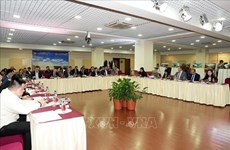Mekong Delta, ideal location for waterway traffic development
The Cuu Long (Mekong) Delta in general and An Giang province in
particular have favourable conditions to develop waterway transport
systems that will boost commerce and ease road traffic congestion in
tandem.
The Cuu Long (Mekong) Delta in general and An Giang province in
particular have favourable conditions to develop waterway transport
systems that will boost commerce and ease road traffic congestion in
tandem.
The statement was made by experts at a seminar on "Management of Transport Infrastructure Development in the Cuu Long ( Mekong ) Delta" held in Can Tho City.
A coastline that is more than 700km long as well as numerous canals and rivers that crisscross each other make the Cuu Long (Mekong) Delta an ideal location to develop an efficient waterway transport system, according to experts.
Doan Canh Hoan, an expert from the Ministry of Transport, said that An Giang province was one of the Delta provinces that can develop roadway and waterway networks while promoting agriculture and aquaculture.
The province has more than 2,400km of waterways including rivers and canals that do not only form a huge aquacultural resource, but also brings in large amounts of silt annually from upstream areas, providing fertile soil for agricultural development.
He said the province's roadway network covers 3,424km with 1,200 bridges that span its rivers and canals.
The main hurdle facing the delta in developing its road and waterway transport systems was the lack of investment that must be raised at home and abroad, speakers agreed at the seminar.
Relevant agencies have estimated that a fund of 100 trillion VND (nearly 5 billion USD) would be needed by 2015 (with a vision to 2020) to develop the transport system in the delta's 13 provinces.
The delta comprises the provinces of An Giang, Long An, Tien Giang, Bac Lieu, Ca Mau, Dong Thap, Can Tho, Vinh Long, Tra Vinh, Soc Trang, Ben Tre, Kien Giang, and Hau Giang.
Hoan said that the delta plans, over the next decade, to continue developing high-standard inland waterway routes, invest in seaports to enable large vessels to enter the region, upgrade the Ca Mau Airport and put the Phu Quoc Airport into service.
Pham Dinh Cuong, director of the Public Asset Management under the Ministry of Finance, said the Cuu Long ( Mekong ) Delta aimed to meet the demand for passenger and cargo transport by 2020, offering good quality at affordable prices. By 2030, the region would be able to satisfy international standard transport needs and services, he added.
In fact, by 2030, a smooth and safe transport system with high connectivity would have been developed in the delta, he said.
Other transportation targets for the region included the completion of five main overland routes – the National Highway 1A, N1 and N2, a coastal route, and the HCM City-Can Tho Expressway, he said.
The region would also strive, by then, to finish the construction of big bridges like Vam Cong, Cao Lanh, Co Chien and Nam Can, and have roads linking all its communes.
Earlier, on July 6, the Project Management Unit of Southern Inland Waterways (PMU S.I. Waterways) inked three contracts with successful bidders for the World Bank-backed Cuu Long ( Mekong ) Delta Transport Infrastructure Development Project.
A World Bank loan and a grant from the Australian government through its development aid organisation, AusAID, fund the 312 million USD project, also called WB5.
The project aims to improve traffic system in the Cuu Long ( Mekong ) Delta region, minimise traffic jams on main roads and waterways, reduce transportation costs between production areas and consumer markets, and support hunger eradication and poverty reduction efforts in the region.
It will dredge canals, strengthen canal banks, and build frontage roads and bridges.
The three winning contractors are: Uniconsult Consulting ( Germany ); Halla Engineering-&Construction Corporation ( Korea ); and a Joint Venture between Khanh Giang ( Vietnam ) &Dredging International Asia Pacific ( Singapore )./.
The statement was made by experts at a seminar on "Management of Transport Infrastructure Development in the Cuu Long ( Mekong ) Delta" held in Can Tho City.
A coastline that is more than 700km long as well as numerous canals and rivers that crisscross each other make the Cuu Long (Mekong) Delta an ideal location to develop an efficient waterway transport system, according to experts.
Doan Canh Hoan, an expert from the Ministry of Transport, said that An Giang province was one of the Delta provinces that can develop roadway and waterway networks while promoting agriculture and aquaculture.
The province has more than 2,400km of waterways including rivers and canals that do not only form a huge aquacultural resource, but also brings in large amounts of silt annually from upstream areas, providing fertile soil for agricultural development.
He said the province's roadway network covers 3,424km with 1,200 bridges that span its rivers and canals.
The main hurdle facing the delta in developing its road and waterway transport systems was the lack of investment that must be raised at home and abroad, speakers agreed at the seminar.
Relevant agencies have estimated that a fund of 100 trillion VND (nearly 5 billion USD) would be needed by 2015 (with a vision to 2020) to develop the transport system in the delta's 13 provinces.
The delta comprises the provinces of An Giang, Long An, Tien Giang, Bac Lieu, Ca Mau, Dong Thap, Can Tho, Vinh Long, Tra Vinh, Soc Trang, Ben Tre, Kien Giang, and Hau Giang.
Hoan said that the delta plans, over the next decade, to continue developing high-standard inland waterway routes, invest in seaports to enable large vessels to enter the region, upgrade the Ca Mau Airport and put the Phu Quoc Airport into service.
Pham Dinh Cuong, director of the Public Asset Management under the Ministry of Finance, said the Cuu Long ( Mekong ) Delta aimed to meet the demand for passenger and cargo transport by 2020, offering good quality at affordable prices. By 2030, the region would be able to satisfy international standard transport needs and services, he added.
In fact, by 2030, a smooth and safe transport system with high connectivity would have been developed in the delta, he said.
Other transportation targets for the region included the completion of five main overland routes – the National Highway 1A, N1 and N2, a coastal route, and the HCM City-Can Tho Expressway, he said.
The region would also strive, by then, to finish the construction of big bridges like Vam Cong, Cao Lanh, Co Chien and Nam Can, and have roads linking all its communes.
Earlier, on July 6, the Project Management Unit of Southern Inland Waterways (PMU S.I. Waterways) inked three contracts with successful bidders for the World Bank-backed Cuu Long ( Mekong ) Delta Transport Infrastructure Development Project.
A World Bank loan and a grant from the Australian government through its development aid organisation, AusAID, fund the 312 million USD project, also called WB5.
The project aims to improve traffic system in the Cuu Long ( Mekong ) Delta region, minimise traffic jams on main roads and waterways, reduce transportation costs between production areas and consumer markets, and support hunger eradication and poverty reduction efforts in the region.
It will dredge canals, strengthen canal banks, and build frontage roads and bridges.
The three winning contractors are: Uniconsult Consulting ( Germany ); Halla Engineering-&Construction Corporation ( Korea ); and a Joint Venture between Khanh Giang ( Vietnam ) &Dredging International Asia Pacific ( Singapore )./.












